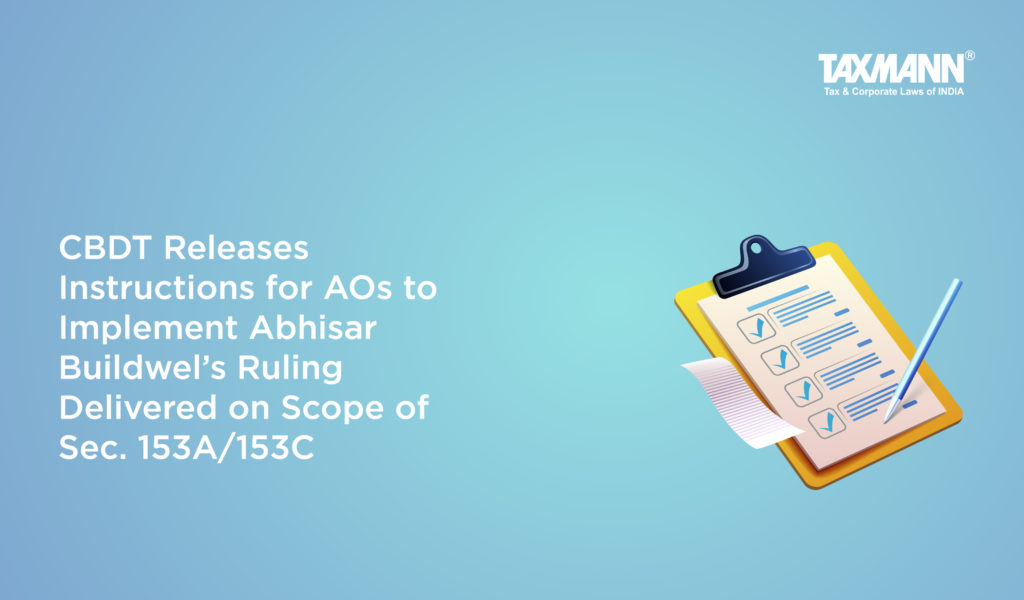CBDT Releases Instructions for AOs to Implement Abhisar Buildwel’s Ruling Delivered on Scope of Sec. 153A/153C
- Blog|News|Income Tax|
- 2 Min Read
- By Taxmann
- |
- Last Updated on 28 August, 2023

Instruction 1 of 2023, dated 23-08-2023
The Supreme Court, in the case of Abhisar Buildwell [2023] 149 taxmann.com 399 (SC), provided power to the Assessing Officer (AO) to reopen the completed/unabated assessments, subject to fulfillment of the conditions as mentioned under sections 147 if no incriminating material is found during the search.
Accordingly, exercising powers under section 119, the Central Board of Direct Taxes (CBDT) issued the instruction for AOs implementing the above judgment while framing assessments. The AOs are directed to divide the cases impacted by the judgment into two broad categories:
I. Pending/abated assessments
AO would be required to ascertain assessments falling in the category of assessments that became abated on the date of the search or requisition. In such cases, if any proceedings initiated or any order of assessment or reassessment has been annulled in appeal or in any other legal proceedings, the same shall stand revived from the date of receipt of the order of annulment as per the provisions of section 153A(2). The AO would need to take necessary action as per the provisions of section 153A(2) read with section 153(8), in respect of such pending/abated assessments.
II. Completed/unabated assessments
In respect of assessments that were unabated/completed at the time of issue of notices under section 153A/153C, the following scenarios will emerge:
a) Lead and all the tagged cases
AO will be required to reopen the cases following the procedure prescribed under section 148A in accordance with the law laid down by the Hon’ble Supreme Court. In view of the specific provisions of section 153(6), all the cases reopened under section 147/148 will be required to be completed by 30th April 2024.
b) Cases where an appeal is pending (filed either by the Department or the assessee or both) before:
-
- CIT(A): The said judgment is required to be brought to the notice of CIT(A).
- ITAT: The departmental representative should bring the said judgment to the notice of the ITAT in the cases covered by the judgment.
- High Court: The Standing Counsel should bring the said judgment to the notice of the High Court in the cases covered by the judgment.
c) Cases where the decisions of appellate authorities rendered after the Supreme Court judgment are inconsistent with the same:
Necessary action may be taken to file Miscellaneous Application (MA) and Notice of Motion (NoM) to the ITAT and High Court, respectively, requesting the review of the decision in line with the Abhisar judgment, with a prayer for condonation of delay, wherever necessary.
It is brought to attention that the time limit for filing a Miscellaneous Application before the ITAT is 6 months from the end of the month in which the order is passed by the ITAT, as per section 254. On receipt of the decision of the Hon’ble ITAT/High Court, as the case may be, necessary action as per law and extant instructions should be taken.
The CBDT also enlists the procedure to be adopted along with necessary actions by the AO in order to implement the judgment of the Supreme Court.
Click Here To Read The Full Instruction
Disclaimer: The content/information published on the website is only for general information of the user and shall not be construed as legal advice. While the Taxmann has exercised reasonable efforts to ensure the veracity of information/content published, Taxmann shall be under no liability in any manner whatsoever for incorrect information, if any.

Taxmann Publications has a dedicated in-house Research & Editorial Team. This team consists of a team of Chartered Accountants, Company Secretaries, and Lawyers. This team works under the guidance and supervision of editor-in-chief Mr Rakesh Bhargava.
The Research and Editorial Team is responsible for developing reliable and accurate content for the readers. The team follows the six-sigma approach to achieve the benchmark of zero error in its publications and research platforms. The team ensures that the following publication guidelines are thoroughly followed while developing the content:
- The statutory material is obtained only from the authorized and reliable sources
- All the latest developments in the judicial and legislative fields are covered
- Prepare the analytical write-ups on current, controversial, and important issues to help the readers to understand the concept and its implications
- Every content published by Taxmann is complete, accurate and lucid
- All evidence-based statements are supported with proper reference to Section, Circular No., Notification No. or citations
- The golden rules of grammar, style and consistency are thoroughly followed
- Font and size that’s easy to read and remain consistent across all imprint and digital publications are applied




